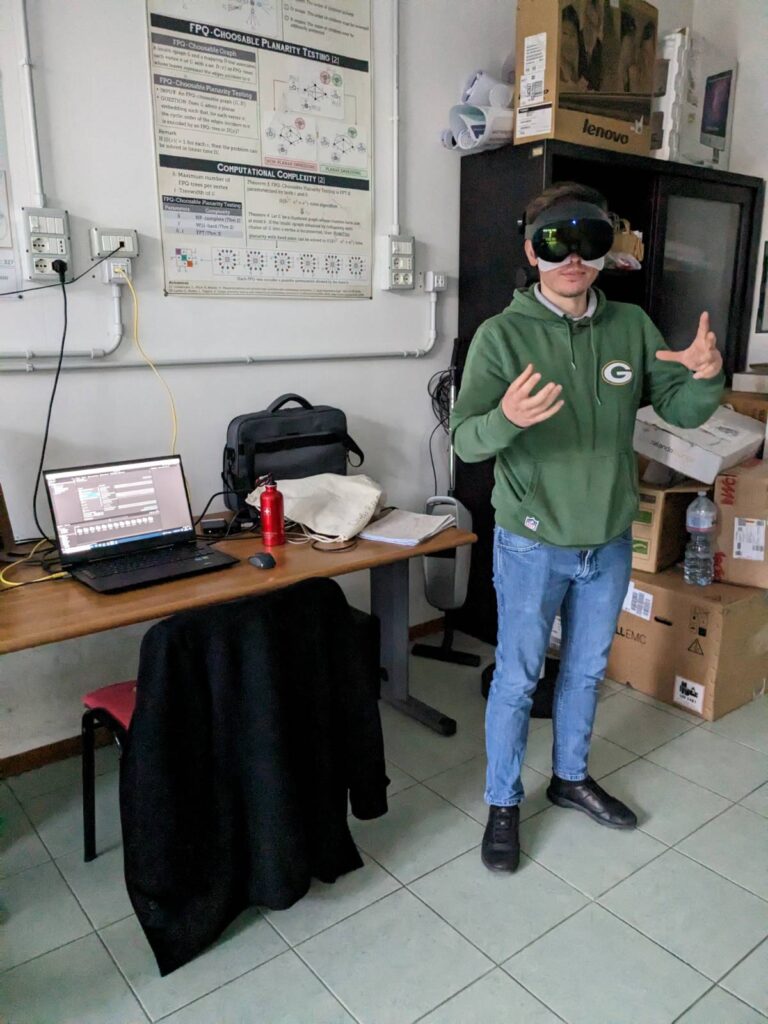I am grateful for having received support as part of the integrated training group of the SFB-TRR 161 for a research stay at Perugia University, Italy from February 15 to April 2, 2023.
I was able to do this research stay as member of research project INF, “Collaboration Infrastructure” of SFB-TRR 161. There, work package 4 “Shared platform for augmented and virtual reality” of the second funding period aimed to investigate requirements, design, and implementation of the shared platform. The research thus focused on collaboration, in particular collaboration in and for immersive environments. On a software engineering level, the aim was to provide researchers with an easy to use, controlled virtual environment, where applications could be shared collaboratively, and experiments could be run. On a more fundamental research level, extending our understanding of collaboration in immersive environments had wide-ranging applications and designs.
During my research stay, I joined the Algorithmics group at the University of Perugia, led by Prof. Giuseppe Liotta. The team at Perugia boasts many expert researchers in the area of algorithmics and graph drawing, such as Fabrizio Montecchiani, Emilio Di Giacomo to name a few. A further testatement to the group’s valued expertise is the organization of the conference on Graph Drawing 2023, the premier venue in the research area. The group’s focus contributed greatly in situating, planning, and designing for a user experiment on collaboration for complex problem solving in immersive environments, the goal of this research stay.
I collaborated closely with Tommaso Piselli on designing a user experiment to investigate collaboration for varying levels of problem complexity, and how problem solving was affected by the spatial representation and topology of the underlying network. We collected related work from a number of fields, due to the interdisciplinary nature of the topic: cognitive psychology, human-computer interaction, information visualization, and immersive analytics, as well as graph theory. With that, we explored the design space of the experiment, ranging from applications and use cases, graph tasks, types of networks, interaction and navigation concepts, and types of environments. We formulated a number of hypotheses and determined a range of measures from existing literature and our discussions, in relation to the research question.

Based on our discussions, I implemented a prototype in Unity, that was able to process networks, generating a 3D layout, and calculating network properties, in order to run an experiment in mixed reality using a Meta Quest Pro headset and hand tracking. The prototype was iterated over in expert meetings. Interesting research questions came up also in regards to 3D force-directed layouting and network representations.
Finally, upon collecting preliminary evidence, final design changes and decisions, e.g. related to effect and sample size, are conclusively set. After analysing all collected data, we plan to submit our results to a suitable computer science conference or journal at the intersection of collaboration, graph theory, psychology, and VR, and more broadly visual computing.
I have learned a lot from this research stay at Perugia University. Not only was the stay an excellent opportunity to live abroad in a different culture, but also very interesting to see the different approaches our groups take to tackling research problems. I benefitted greatly from the insights my colleagues shared in and well beyond the topics of network science and graph drawing, as well as experiment design. I want to thank Beppe and all members of the group for the warm welcome I enjoyed. I want to thank the DFG for funding this research stay.
